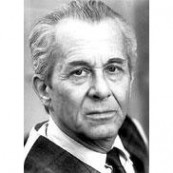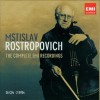Composers
Karen Surenovich Khachaturian
| Country: | USSR, Russia |
| Period: | XX age |
Karen Surenovich Khachaturian (Russian: Карэн Суренович Хачатуря́н, Armenian: Կարեն Խաչատրյան) (September 19, 1920 – July 19, 2011) was a Soviet and Russian composer of Armenian ethnicity and the nephew of composer Aram Khachaturian.
Khachaturian was born in Moscow, the son of Suren Khachaturian, a theatrical director. He studied under Genrikh Litinsky at the Moscow Conservatory were interrupted by a term of duty in the entertainment division of the Red Army. Resuming his studies in 1945, he worked with Dmitri Shostakovich and Nikolai Myaskovsky.
In addition to the Violin Sonata (1947), his works include a Cello Sonata (1966), a String Quartet (1969), four symphonies (1955, 1968, 1982, 1991) and a ballet, Cipollino (1973), as well as various other orchestral works and music for the theater.
Rhythmic drive and a careful and idiomatic use of his instrumental forces characterize his compositions. He adopted a primarily tonal approach to composition. His works have been recorded by some of the greatest artists of the 20th century, including David Oistrakh, Jascha Heifetz, Mstislav Rostropovich, and Vladimir Yampolsky.
Refine by search
view allBiography
Karen Surenovich Khachaturian (Russian: Карэн Суренович Хачатуря́н, Armenian: Կարեն Խաչատրյան) (September 19, 1920 – July 19, 2011) was a Soviet and Russian composer of Armenian ethnicity and the nephew of composer Aram Khachaturian.
Khachaturian was born in Moscow, the son of Suren Khachaturian, a theatrical director. He studied under Genrikh Litinsky at the Moscow Conservatory were interrupted by a term of duty in the entertainment division of the Red Army. Resuming his studies in 1945, he worked with Dmitri Shostakovich and Nikolai Myaskovsky.
In addition to the Violin Sonata (1947), his works include a Cello Sonata (1966), a String Quartet (1969), four symphonies (1955, 1968, 1982, 1991) and a ballet, Cipollino (1973), as well as various other orchestral works and music for the theater.
Rhythmic drive and a careful and idiomatic use of his instrumental forces characterize his compositions. He adopted a primarily tonal approach to composition. His works have been recorded by some of the greatest artists of the 20th century, including David Oistrakh, Jascha Heifetz, Mstislav Rostropovich, and Vladimir Yampolsky.



